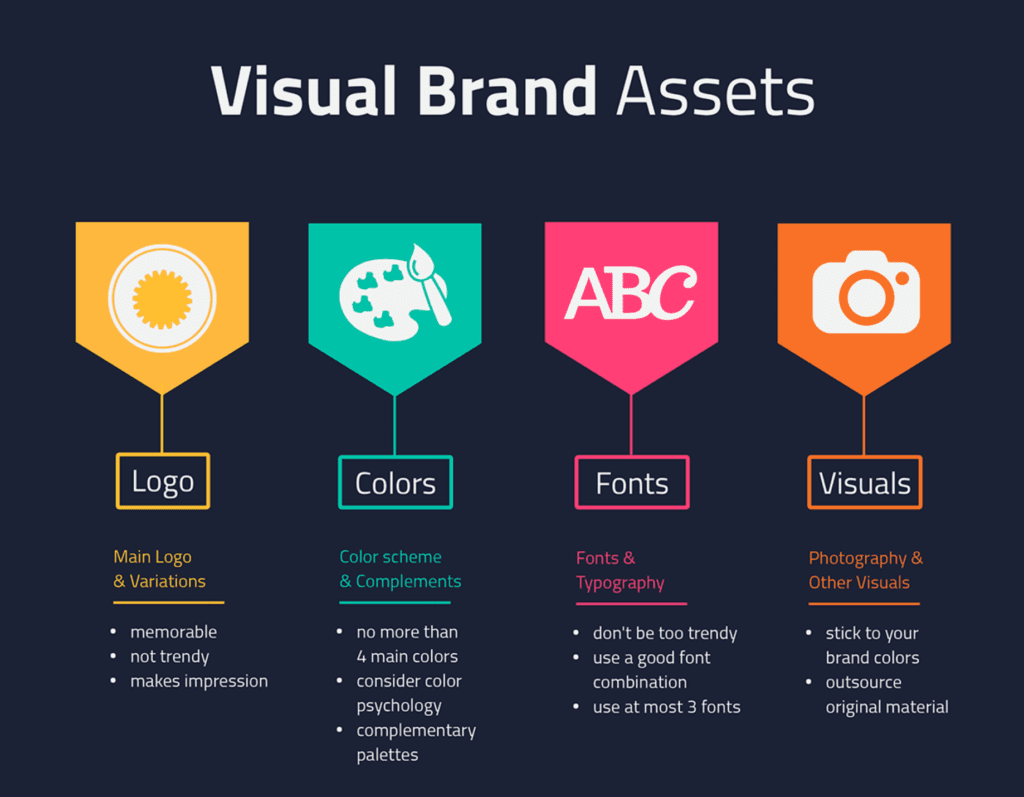A brand is so much more than just products and services. A brand is all about the perception of others who interact with it. Just as a personality for people.
And in a world where opinions and narratives about a brand can affect its success, brand management is crucial.

Without proper brand management, there is no consistency in a brand’s personality. So, the outside narrative will determine how everyone sees the brand.
That’s not good.
Brand managers help define the narrative and help brands be perceived the way they want to be perceived.
But it’s no easy task.
This is why we’ve created this guide. To help brand managers and companies manage and improve the most important aspects of their brand.
But first, let’s define what exactly is brand management.
What is brand management?
Why brand management is important
The role of a brand manager
Brand management principles
Brand asset management
How to be a successful brand manager
What is brand management?
Brand management is the process of maintaining a consistent brand identity and improving consumer’s perception of a brand with the purpose of building brand awareness, loyalty, and brand equity.
This concept should not be confused with branding, which is a different thing. Branding focuses on shaping the brand and developing its voice.
On the other hand, brand management focuses on making sure that the brand’s communication, advertising, content, and general style are consistent with the branding.
Both concepts work together, but one comes up with the ideas and the other ensure they succeed.
In a way, you can think of brand management as the process of finding the right words to tell a story. The story that your brand wants to tell. Without it, the story won’t be interpreted correctly.
These are some of the things that great brand management can accomplish:
- Increase brand loyalty
- Increase brand awareness
- Increase product prices
- Increase word of mouth recommendations
- Increase sales
Why brand management is important
We briefly mentioned that a brand’s identity and perception are important for its success. But, how important is it really?
Take a look at this statistic.
A brand’s consistent presentation can increase revenue by 33%.
As you can see, consistent branding has a lot of value for consumers. Achieving consistency in all aspects is one of the main goals of brand management.
And people not only care about a consistent presentation. They also care about authenticity. In fact, 90% of consumers say that authenticity is important when deciding which brands they like and support.
It’s clear that brands are affected by people’s opinions about them. And those opinions are based on many factors, not just the product or service. Factors like values, messaging, style, external news, etc.
Even the colors a brand uses have an effect on opinions. Having a signature color increases brand recognition by 80%.
Now consider that people only take 0.05 seconds to form an opinion about your website. That number should be similar for other brand aspects.
Another statistic to take into account is that 64% of people would support or boycott a brand just based on its position on social or political issues. Proving that many people buy on beliefs.
There are many situations that can put a brand in an uncomfortable position. But through intelligent brand management, brands can come out on top every time.
The role of a brand manager
Consumers sometimes don’t see how much effort is put into building a brand with a consistent identity. It’s not an easy task. And brand managers are the ones in charge of it.
The main role of a brand manager is to provide the organization’s teams with a strategy, guidelines, and research to effectively build a positive brand reputation with consumers.
For this purpose, brand managers:
- Create and manage brand assets
- Create guidelines and style guides
- Define the value proposition
- Take part in all communications from the brand
- Help with product development
- Create marketing collateral
Among other things. Basically, brand managers allow the company to develop powerful messaging, marketing campaigns, brand image, and products that resonate with consumers.
Now let’s take a look at the principles that brand managers work with, and how to improve them.
Brand management principles
With brand principles, we mean the marketing concepts that brand managers try to improve with their work.
These principles are:
- Brand Awareness
- Brand loyalty
- Brand equity
- Brand reputation
- Brand recognition
- Brand community
You are probably familiar with all of them, but in this section, we will talk about the most important aspects of it and strategies you can use to achieve the brand’s goals.
Brand Awareness
Brand awareness is the process of getting new people to know about a brand, product, or service. It’s one of the most important aspects of marketing and one of the main goals of most campaigns.
Brands constantly need to be in front of new people to get new customers. But brand awareness is not only about getting in front of as many people as possible.
It’s about getting discovered by people in your target market. People that actually have a chance of converting to a customer.
It’s clear why brand awareness is crucial for businesses. It allows brands to reach new audiences and let people know about their solutions.
For someone to purchase a product, they first need to be aware of it.
Brand managers have many tools to increase it. They can define a brand voice that appeals to their target audience and use it in social media to generate engagement.
Another strategy that takes brand awareness to the next level is executing an ambassador marketing campaign.
This type of campaign is one of the best ways to reach a large number of people in your target markets. This strategy works because ambassadors represent the brand’s voice while using social media and in-person activities to reach as many people as they can. Also, brand ambassadors are more trusted than advertising and content from the brand itself.
Check out our ambassador marketing guide to know more.
Brand Loyalty
Brand loyalty refers to the loyalty customers develop towards a brand resulting in repeat purchases over time.
A person becomes loyal to a company when they love the products. However, most of the time, that is not the only factor. People also care about the user experience and want to connect with the brand on a deeper level.
If you think about it, what is stopping customers from changing brands and going to the competition?
The answer is their connection with the brand. This connection makes people want to support the brand because they like the products as well as everything else the brand represents.
Brand loyalty is important because most of a brand’s business comes from current customers. 65% actually.
So, what can a brand manager do to increase brand loyalty?
The first thing that a brand manager needs to take a look at, is the identity. He or she should develop a strategy to have a brand identity that resonates with the customers. If the branding strategy is already established, then the manager has the responsibility to make sure everything, the website, marketing collateral, social media content, communication, etc. is consistent with it.
Then, the brand can create a loyalty program. Loyalty programs are a way to incentivize repeat purchases by giving the customers rewards for each purchase.
These rewards are usually points that can be exchanged for a product once the customer has gathered a certain amount. This is the most common way they work, however, it’s not the only way.
Brand Equity
Brand equity is the weight a brand has over the value of a product in the consumer’s mind. Let’s put this simply through an example.
Brand equity is what makes a fashion brand more expensive than a regular brand. Sure, the quality in some products might be higher, however, the brand name and reputation are what make the difference in price.
This happens because of the perception people have over brands. Even if the cost is very high in comparison, consumers decide whether it’s worth it based on more than just the quality. They decide based on the idea that it’s superior, created by consistent marketing efforts over the years.
This principle is important because, in a way, consumers are the ones who set prices. They decide what is worth spending on a particular product. So, recognized brands that are perceived to be of high value will be able to charge more.
This is something that great brand management can achieve, if it’s one of the company’s goals.
To increase the value proposition of products, brand managers need to create positive experiences for consumers, increase awareness, and establish an identity that expresses high quality and high value.
All through consistent brand assets. More on brand asset management below.
Brand Reputation
Brand reputation is the overall opinion about a brand. How people see it. You can think of it as the reputation of a person, but for a brand.
Something becomes part of a brand’s reputation when it happens repeatedly and people talk about it.
If you offer good customer service consistently, and people mention this when talking about your brand, that will become part of your reputation.
The reputation of a brand can determine if people trust it or not. And without trust, there won’t be many purchases.
So, it’s very important to have a positive reputation in as many aspects as possible.
To achieve this, brand managers need to help provide positive experiences for consumers. Experiences like great social media presence or customer service. By creating consistent experiences, people will like the brand more and this will lead to a revenue increase. As we pointed out at the beginning of this article.
Brand Recognition
Brand recognition refers to a brand’s ability to be easily recognized, even without seeing its name. So, everything else that is unique about the brand such as, logo, packaging, sounds, colors, etc.
The main point of brand recognition is that consumers keep a brand at the top of their mind, above the competition, when making a purchase decision.
The elements that make a brand recognizable are the ones that make it memorable.
Brand managers are tasked with creating style guidelines for marketing campaigns to make them stand out while being on-brand.
Brand Community
Another responsibility of brand managers is community management. This is a role that was added to the brand management position since brand communities have grown in the world of marketing.
For many organizations, the community manager is the new brand manager. This happened because, as we mentioned before, consumers now are buying based on the product, experience, perception, trust, community, and many other factors.
Community has a special focus for marketers nowadays because people want to connect and have an authentic relationship with brands.
The community manager/brand manager handles this relationship between brand and customer in order to create a genuine experience they can connect with.
Building a brand community is important because it helps reach the goals we have been talking about in this article. For example, increase awareness, brand loyalty, and word of mouth recommendations.
Creating on-brand content, encouraging user generated content, building an ambassador program or a referral program, and interacting with customers through social media are some of the ways brands can grow their community.
Recommended: The Ultimate Community Management Guide: Keeping Your Best Ambassadors Engaged
Brand asset management
Brand assets are the components that brand managers use to accomplish the previously mentioned goals. Meaning everything that employees and customers see and interact with.
With this in mind, brand asset management is the process of planning, creating, and maintaining brand assets like branded content, logo, style guidelines, graphics, colors, packaging, etc.
These are some of the tasks brand managers have for managing brand assets:
- Planning and creating assets that are consistent with the branding strategy
- Organization of digital and physical assets
- Letting departments know how to access the assets
- Regularly checking if the assets are still consistent with the branding
How to be a successful brand manager
Brand managers are crucial for the success of brands. Through their work, they are able to increase brand awareness, loyalty, equity, recognition, and improve the reputation of a brand. Without good management of these aspects, companies wouldn’t do too well.
But being a brand manager is not easy. To be a successful one requires the following characteristics:
- Great communication skills
- Customer-centric
- Storytelling skills
- Analytical
- Social media expert
- Tech-savvy
- Data-driven
These characteristics make for great brand managers, so if you are in charge of this role, make sure you keep them in mind.




